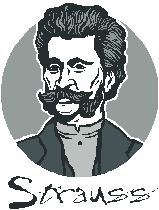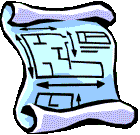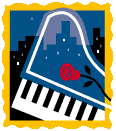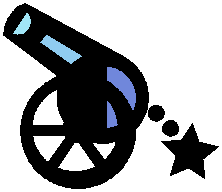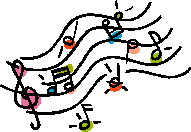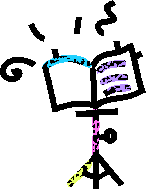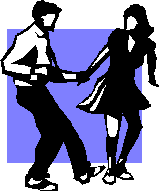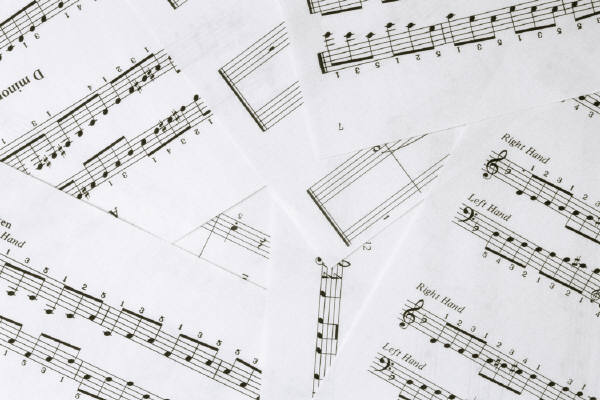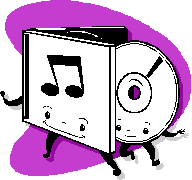Sunday, August 31, 2008
What is a "Waltz"?
The waltz is a genre of music primarily intended for the purpose of dancing the waltz, a graceful, intimate ballroom dance, and later of course, listening to the artistry of the composer and performers of the waltz. Waltz music is always in 3/4 time with a strong emphasis on the measure's first beat -- think TRA-la-la, TRA-la-la. Each measure generally contains only one chord, and that chord is preceded by a bass note played on the first downbeat; the TRA represents the bass, and the la represents the chord. Waltz is a gentle, flowing style of music, a style so elegant that it is often associated with the upper class and aristocratic finery.
But the ties between the waltz and the rich haven't always been so solid. In fact, an overwhelming majority of the upper class shunned waltz music until Austrian composer Johann Strauss Sr. began toying with the style. Prior to Strauss Sr., the waltz was typically thought of as too common, too entwined with the peasant culture. But Strauss Sr., in conjunction with another Austrian composer, Josef Lanner, brought a new sort of grace to the waltz, an elegance and gentleness that was very easily embraced by the upper class. Strauss Sr. and Lanner made waltz music listenable for its own sake; before them, waltz music was rarely heard outside of the dance.
While Strauss Sr. and Lanner popularized the waltz worldwide (or at least throughout Europe), it wasn't until Johann Strauss Jr. that the waltz became massively popular in Vienna. Strauss Jr., taking a cue from his incredibly influential father, began composing a form of the waltz much faster and energetic than those written by Strauss Sr. and Lanner. This type of waltz music spawned a new, faster form of the dance, the Vienna Waltz, which is still danced today. It was Strauss Jr. that created the type of waltz we now hear so frequently, and his contribution to the form gave him the title "Waltz King." "The Blue Danube," perhaps the most famous waltz in history, was composed by Johann Strauss Jr.
Saturday, August 30, 2008
What is a digital piano?
A digital piano is an electronic, keyboard-based instrument similar to a synthesizer but made to function more like a piano than any synthesizer does. A digital piano actually falls in category somewhere between synthesizers, which are made to produce extremely artificial sounds, and electronic pianos, which are made to be portable versions of pianos. A digital piano typically contains many piano-like features, such as full 88 key keyboards (though some are much smaller), a variety of different functioning pedals and weighted keys. But the sounds found on a digital piano vary from that of both an acoustic piano and a synthesizer. While a digital piano always includes a normal grand piano sound of some sort, it may also contain the sounds of other piano types, such as honky-tonk or upright. Additionally, a digital piano will often include sounds complementary to a piano, such as strings, brass and percussion.
What makes a digital piano sometimes more desirable than an acoustic piano (when it comes to popular music, at least) is the sheer number of features that enhance the experience of playing. For instance, one push of a button can transpose the entire keyboard on a digital piano to any key desired and middle C can be placed anywhere on the keyboard. Additionally, the keys on a digital piano can be adjusted to have as much or as little touch sensitivity as the pianist desires. A digital piano can also control a variety of audio functions, including sustain and delay, and be used as more of a synthesizer than a piano. And what's more, a digital piano can be programmed to play more than one sound when kitting a key or the keyboard can be split to put the bottom half at one sound and the top half at another. It's an extremely versatile instrument; a digital piano can be made by its user to sound exactly like a real piano or anything but.
Friday, August 29, 2008
What does "Musical Form" mean?
Musical form is most often based on the idea of statement and restatement -- introducing one or more themes and repeating them throughout the song, sometimes exactly the same, sometimes changed. Pop music, for instance, relies heavily on this idea. A pop song's chorus (frequently the catchiest part) will be repeated several times throughout, but it will sometimes be slightly altered to incorporate a solo or different vocal melody. Similarly, a pop song's verse could be in complete contrast to the chorus, but it will almost always complement it. This technique of statement and restatement, contrast and complement, is the very base of a song's musical form.
Musical form comes in many varieties and with countless labels, but the most widely recognized are sectional, developmental and variational musical form:
Sectional musical form consists of smaller sections or parts combined in various ways to create a piece of music. Binary musical form (ABAB) is a sectional musical form using repetition, with A and B representing two different parts; pop music tends to rely heavily on binary musical form.
Developmental musical form is created by introducing one or more themes (as opposed to individual parts) and presenting or combining them in different ways throughout the piece; the most common developmental musical form is the symphonic sonata-allegro musical form.
Variational musical form combines traits of both the sectional and developmental musical forms. Like sectional, it relies on smaller sections or parts combined to create a whole. Variational musical form, however, gives a different treatment to each section before repeating it; where developmental musical form changes the presentation of the material, variational musical form changes the material. This can be done by altering melody, harmony or even instrumentation. Jazz improvisation is the most well-known example of variational musical form.
Thursday, August 28, 2008
What is an "opera"?
Opera is the earliest form a musical theater; it is, simply, a play in which every piece of dialogue is sung, not spoken -- where a play has a script, an opera has a libretto. The form is very distinctive, known mostly for a very particular style of singing that requires an incredible range. But while many opera singers feel they have an inherent ability simply on the basis of their high notes, the form is much more complicated than that. Opera requires a vocalist to not only sing complicated parts flawlessly but dance and act flawlessly as well; it's an extremely extensive type of performance.
The vocal parts in an opera are classified in the same manner as a choral arrangement, but there are several subdivisions to each category. For instance, opera requires more than five different types of soprano, most of which don't have that classic opera tone; some act as something of a higher range alto, filling in harmonies and integrating the chorus. It's the lead soprano, or dramatic soprano, that has the distinctive opera tone; because of that, dramatic sopranos are always the female leading roles in an opera.
The actual vocal compositions in an opera are of two different forms: aria and recitative. An opera aria is a wholly composed and developed song, one that tends to stop the plot dead in its tracks and focus on the feeling of one specific moment. While opera arias have recently come to refer to a solo piece, they can be sung by any number of individuals. A recitative piece in an opera, on the other hand, is the actual dialogue of the opera, the talking back and forth. It's a composed song, obviously, but tends to not be as structure or developed as an opera aria; the melodies are loose, the focus more on the content than the form. While opera arias are usually given the golden limelight by audiences and critics, its the recitative pieces that truly move the opera forward. Without them, the opera would simply not be an opera.
Wednesday, August 27, 2008
What is "sonata form"?
Sonata form is a very rigid method of musical composition; it can refer to either an entire piece of music or the first movement of a symphony. Though sonata form is an integral part of a symphony, sonata form as an entire piece of music tends to be a bit more complicated as more attention and time is given to each individual part within the intricate composition.
Sonata form is generally divided into five parts: introduction, exposition, development, recapitulation and coda. The introduction within sonata form is generally the shortest part of the piece, at times omitted completely if it isn't completely necessary. A sonata form introduction is often dynamic-building, a slower part that increases with weight as it moves forward, pushing the song toward the exposition -- the most important part.
The sonata form exposition is the meat of the song, the area in which the major thematic subjects are introduced. The exposition itself is divded into a series of subject groups. The first subject group in sonata form introduces a theme, followed by a brief transition used to switch keys. The second subject group brings altered melodies into the sonata form in a different key than the first group; it is primarily used to change the piece's mood. It is followed by the sonata form codetta, which revisits various themes within the exposition and signals the end of the part.
Sonata form development is exactly that: development of the subject found in the exposition. In order to make the sonata form development work effectively, however, the subjects have to be very altered, sometimes introducing one or two elements completely new to the song. It is followed by the sonata form recapitulation, which revisits the exposition. It is divided into the same groupings as the original exposition with the parts unchanged -- except for the transitional key change, which is usually abandoned.
The final part of the sonata form is the coda, a part that essentially repeats the end of the song. The sonata form coda can, of course, be altered, but it is rarely so altered as to become unrecognizable.
Tuesday, August 26, 2008
What in the world is "polytonality"?
Polytonality is the act of using more than two keys (or tonalities) at the same time, in the same piece of music. Bitonality, though often considered to be a part of polytonality, is the act of using only two keys at the same time. Both of these techniques create tension and ambiguity. A fully harmonized polytonality will sometimes add a sense of discomfort (though it doesn't necessarily have to). In fact, a polytonal song often ends with the dominant key in order to keep the song from feeling restless or unresolved.
Polytonality rose to popularity in early 20th century classical music. Though it had been used before in pieces such as Beethoven's Eroica Symphony, it wasn't until the early 20th century that composers began to really explore its possibilities. In some ways, polytonality hit its stride with Arnold Schoenberg, even though he didn't directly experiment with the form. After years of composing and pushing tonality to its limits, he decided to abandon the concept altogether. This created a concept called atonality. At the same time, Igor Stravinsky (who was also frustrated with the constraints of tonality) began experimenting with polytonality as a way to break through the tonal walls. These two concepts, polytonality and atonality, eventually unofficially banded together to form a musical movement based on the era's increasing irritation with strict musical rules. This movement brought polytonality to the fore and led many musicians to experiment with the idea.
The most well-known examples of polytonality are found in Stravinsky's ballet Petroushka (which is actually bitonality) and his piece The Rite of Spring. And while Stravinsky eventually went on to experiment with serialism, many other 20th century composers took his cue and used polytonality in their pieces. Charles Ives, for example, was one of the first to use fully harmonized bitonality in classical music; Darius Milhaud also used it frequently. Other notable composers involved with polytonality include Gustav Mahler and Phillip Glass.
Monday, August 25, 2008
What is a "musical canon"?
__A musical canon is a piece of music that showcases one melody adapted to various forms, each form shadowing the other. Perhaps the most well-known musical canon is "Pachabel's Canon." It's an amazing example of how the form works; one melody is changed slightly over the song's duration and the variations shadow each other at set points. But the melody in a musical canon doesn't necessarily have to change. Consider the "Row, Row, Row Your Boat"-type round; the melody in this musical canon stays exactly the same, letting the shadowing take center stage.
The musical canon comes in numerous shapes and sizes, but the most familiar (and frequently used) types are the inverse musical canon, the contrapuntal canon and the backwards canon. The inverse musical canon is precisely what the name denotes: a musical canon in which one or more melodies are inverted. Note, however, that this doesn't mean the melody itself is played backwards; the inverse musical canon inverts only intervals -- where the lead melody moves a third up, for example, the following melody moves a third down.
The contrapuntal musical canon is like "Pachabel's Canon"; the melodies are all slightly different but work well together and shadow each other in the same places. The shadowing is the most important thing in the contrapuntal musical canon, as how the melodies link together will ultimately determine their ability to complement each other.
The backwards musical canon is exactly what the inverse musical canon is not; it's a musical canon in which the following melody is played backwards from the lead melody. It's almost like reversing a tape loop; the intervals stay exactly the same, as do the notes, but they're played in the reverse direction from the lead melody in the musical canon.
Friday, August 22, 2008
What is "syncopation"?
Syncopation is a rhythmic technique achieved by placing the stress, or accent, on a normally unstressed beat. Rhythm functions on a series of stressed and unstressed beats that drive the underlying meter. The time signature dictates which beats are to be stressed; for example, typical 4/4 time stresses the first and third beats, while 3/4 stresses only the first. Syncopation would place the stress on a beat other than those mentioned; in 4/4, syncopation might put the stress on the second and fourth beat, for example. Anytime an accent is played on a beat other than that traditionally stressed (regardless of instrument, though drums in pop music usually dictate this), it's syncopation.
Syncopation isn't only found on the straight unstressed beats of a song, however. Often, syncopation will be achieved by placing the stress on the upbeat. Tap your foot in 4/4 time; the point at which your foot is in between taps is the upbeat. This type of syncopation is a half-step off from any defined straight beat and can be used to create energy within a song. Traditional polka and modern ska (a reggae-infused style of rock music) often employ upbeat syncopation within songs; in fact, upbeat syncopation has become the main defining characteristic of modern ska music.
Playing or singing a note just before or after the beat also constitutes syncopation, though this is a trickier sort. Because there's no defined beat on which the syncopation can fall, it takes great care on the musician's part to avoid making this sound like an accident. This type of syncopation requires a natural sense of rubato for the piece in question and can add miles of space to the song's character if used correctly. Rhythm & blues and soul music often use this sort of syncopation, and it has spread to be included in the rhythmic lyrics of many hip-hop songs.
Thursday, August 21, 2008
What is a "serenade"?
A serenade is a piece of music intended to honor a specific person. Though there exists a variety of different types of serenade, the most modern and common notion of the serenade (or the concept of serenading someone) is based on the earliest of all its forms. It's simpler than the majority of serenade styles; just a piece of music played for someone in their presence. During the Medieval era, this performance was usually done underneath the intended's window, which is where the modern pop-culture reference comes from. This type of serenade is all over television and movies; heart-struck men camp out with a guitar underneath their beloved's window, waiting to play the song they so desperately toiled over. And in some cases this serenade notion has taken an extremely modern twist; in the movie "Say Anything," John Cusack's character serenades his loved one by playing a Peter Gabriel song on a large, hi-tech (at least for the time) boom-box. The rules of serenade tradition might be gone, but the general idea is still there.
But aside from that commonly referenced style, the serenade is also a sort of music in its own right. This type of serenade, popularized by Italian and Austrian composers, is a multi-movement piece of music intended for a symphony orchestra. It's less rigid than many symphonic compositions of the time, reflecting a light playfulness very indicative of love and happiness. And also unlike the symphony, this type of serenade is solely dependent on sounds and the mood created by those sounds as opposed to subject exposition and recapitulation. This type of serenade is found most frequently within the Romantic and Classical eras of composition, though it's carried over (and evolved) to modern classical compositions in the form.
_____________________________
Wednesday, August 20, 2008
What Are "Time Signatures"?
Time signatures are the area of western musical notation that give specifics about time and how it will function within the song. The importance of these two numbers is apparent by their placement alone; time signatures are literally the second thing a musician sees, after the clef. One glance at the time signatures and the musician is able to put the entire song into context; not only do time signatures denote rhythm, they can also tell quite a bit about style and genre.
Time signatures consist of two numbers placed vertically on the staff. They appear right after the key signature (if there is one) or the clef (if there isn't). Each number says something different about the piece of music: the top note indicates how many beats are in one measure of music, the bottom indicates which type of note makes a beat (or "gets the beat," in musician-speak). For example, times signatures of 4/4 tell a musician that there are four beats per measure of music and that the quarter note is one beat.
But time signatures aren't always so easy. The above explanation only applies to one type of time signatures, simple time signatures. 4/4 is the most common of the simple time signatures, but 3/4 and 2/4 are used frequently, as well. The other type of time signatures, compound time signatures, tends to be a bit more complicated. Compound time signatures are recognizable by a top number of six or higher that is always divisible by three, like 6/8. To figure out how many beats exist per measure, the top number is divided by three; so in 6/8 time signatures, the top number wouldn't say that there are six beats per measure, but rather two. Likewise, the note type is found by multiplying the bottom number's note value by three; an eighth note doesn't get the beat in 6/8 times signatures, but the dotted quarter note does (a quick note: the note value in compound time signatures will always be dotted). 6/8 and 12/8 are two of the most common compound time signatures, used heavily in waltzes and blues, respectively.
But even compound time signatures don't cover the broad spectrum of rhythms that time signatures have to offer. No, there are still times that a rhythm is so odd, so seemingly offbeat, that the time signatures must be similarly irregular. And that's how we get to irregular time signatures, time signatures that can be categorized into simple or compound, but because of their rare usage and strange rhythm aren't really categorized as such -- like 5/8 or 10/4. Time signatures like these are found pretty frequently in innovative rock and pop groups. The most famous examples of irregular times signatures are found all over Pink Floyd's "Dark Side of the Moon," but bands like Rush and Genesis (early Genesis, before Phil Collins stepped away from the drums) have also used them to marvelous effect.
Monday, August 18, 2008
What is a "polka"?
The polka is a Czech genre of folk dance and music started in Bohemia in the 1830s. It's quick and lively; polka music is always played in 2/4 with four verses and as many repeated choruses (though sometimes the chorus is repeated after every other verse). Unlike many dance-music genres, polka is lyrically solid -- and incredibly diverse. Polka originated in the peasant culture, so the lyrics often reflect that life; and though polka lyrics can really be about almost anything, love and the loss of love seem to be the most common themes.
The polka is distinguishable by a few familiar characteristics. The music itself is very recognizable, some forms creating the oom-pah sound that many identify with only polka. It's always played with a bass, piano and horn section (usually including a tuba), but the most identifiable instrument in polka is the accordion. An image of a man playing an accordion in traditional Czech folk clothing is one that comes to mind for many people when polka is mentioned. The dance, too, is very distinguishable, if only for its vivacious energy. The polka dance is based on a half-step hop taken before the actual step. This hop almost serves a primer for the rest of the dance, and it's what makes the polka dance seem so incredibly bouncy and energetic. The informality of the dance also contributes to its carefree connotation. A typical polka dance will have no strict formation on the dance floor; dancers are free to move around the floor in whatever way feels most comfortable to them and the other dancers.
Though it's often associated with a nerdy, boring lifestyle (parents through the eyes of teenagers are always listening to polka), polka is still wildly popular within the United States. Throughout the years, however, it's morphed into a variety of forms, many of which are extremely regional. The Polish polka is found mostly in Chicago and encapsulates a number of styles. Slovenian polka, which is faster than traditional polkas, is often danced in Cleveland, and Dutch polka (the most familiar and popularized type) is the province of the Midwest.
Sunday, August 17, 2008
Fake piano in opening ceremonies at Olympics?
Fake piano?
Is it possible that a plastic or cardboard piano was used as a prop in the opening ceremonies at the Beijing Olympics? The piano seemed to bounce around as it was played more than a normal grand piano would. And there seemed to be something unnatural about the way the sustain pedal was used.
If so, why would they do that? There doesn't seem to be any point to it. Take a look at it for yourself and see what you think. Go to: http://en.epochtimes.com/n2/china/lang-lang-fake-olympics-2829.html
Saturday, August 16, 2008
What does "modulation" mean in music?
Modulation
Modulation is a fancy word for key change -- switching from one key to another in a single piece of music. It is a common practice in composition (both classical and rock or pop) and can be used to a variety of effects. Modulation can be subtle and smooth or abrupt and startling. It can cast an eerie glow on a piece of music or completely change the mood and direction. The effect achieved, however subtle or abrupt, is largely dependent on the type of modulation used.
The most common type of modulation is called pivot chord modulation. In this type of modulation, the key changes based on a chord shared by both keys; the destination chord often has the same root note or quality as the original chord. This allows for a smooth, almost foreshadowed modulation. A good example of this is found in the last chorus of rock songs; this type of modulation is used there to an almost triumphant effect.
Another common type of modulation is pivot tone modulation. Similar to pivot chord, pivot tone modulation uses a common pitch to move from key to key. This type of modulation is also subtle, depending on the piece of music in which it is used. It can, however, be used to a startling effect if the two keys have few notes in common. In songs using pivot tone modulation, the common pitch is often sustained or repeated and used a bridge between the two keys.
The most abrupt kind of modulation is direct modulation. The name is exactly what is says it is: a direct modulation using no common note or chord to bridge the two keys. When used correctly, direct modulation is shocking and can easily change the song's mood. This type of modulation switches keys either at a phrase's end (phrase modulation) or at a point in the middle of the song (static modulation).
____________________________
Friday, August 15, 2008
What is "Harmony"?
Harmony is a series of notes in combination, played simultaneously or at least tangent. Listen to your favorite songs, and pay close attention to the back-up vocals when they're being sung along with the lead. Can you hear how the two vocal melodies differ in pitch? That's harmony, and it's highly possible that those back-up vocalists were chosen because of their strong ability to harmonize. Singing a harmony, or rather picking one out on your own without written sheet music, is an almost inherent musical skill that many singers would die to possess. But harmony isn't just the province of singers; it's found in every single area of music. Any time a sound is layered on top of another sound and those sounds match each other in rhythm and melody (but not pitch), a harmony is created.
Harmony is made of intervals, and as such, it can be considered dissonant (scratchy, uncomfortable, like playing an E and an F at the same time) or consonant (pleasing or smooth). What makes a harmony pleasing or unpleasing, however, is extremely relative. In medieval times, only octaves and perfect fifths were considered harmonious, and any harmony that deviated from that was generally frowned upon. In modern western music, though, nearly everything is considered to be harmonious by someone. Fifths are still very popular in modern harmony but are now used in the most unlikely of places; heavy metal music, for example, frequently uses perfect fifths in the vocal harmony to create an eerie effect when layered on top of the more dissonant instrumentation.
In addition to being consonant or dissonant, can also be subordinate or coordinate. Subordinate harmony, the tonal harmony used most frequently today, is a series of harmonies that are based on each other. The harmony moves in such a way that a resolution is somewhat predictable; you can hear this type of harmony in modern pop music, musical parts that flow very easily into each other and don't leave the listener baffled as to the turn the song has taken. On the other hand, coordinate harmony is a series of harmonies that operate independently of each other. They do have some common relation, of course, but don't typically move toward a goal, or predictable resolution. Renaissance musicians often used this type of harmony, and it's capable of producing rich and moving textures within a piece of music.
__________________________
Wednesday, August 13, 2008
Music Downloads
Music downloads are highly compressed audio files transferred onto a personal computer from an Internet website or P2P (peer to peer) program. It's a trend reaching nearly epidemic proportions; music downloads are everywhere. Websites all over the Internet offer music downloads of particularly rare or hard-to-find songs, and computer-savvy music fans have been known to spend hours searching through the mountains of downloadable material. They also function as a godsend for new or underground musicians; who needs a record label when strategically placed music downloads alone can garner you a dedicated following? Even cell-phone companies have grabbed themselves a piece of the pie by offering music downloads that serve as ring tones. The sound quality is often superior, the P2P programs easy to use -- music downloads are one of those rare pop-culture phenomena embraced by nearly everyone.
But despite (or perhaps because of) their overwhelming popularity, music downloads have stirred quite the controversy. Many P2P programs allowing users to transfer music directly between computers offer music downloads for free, much to the chagrin of several recording artists and labels. Fearful of losing money to music fans downloading the songs instead of buying the full record, bands and labels have set out to stop the users from obtaining their music from free programs. A virtual witch-hunt for frequent downloaders and the threat of lawsuits led many P2P programs to begin charging for their services, though several sneak under the wire by making that payment optional.
The ethical implications involved in free music downloads are complicated. Some vehemently rail against the practice, claiming that to download free music is to disrespect the artist that created it. Even bands unconcerned with the financial aspect hate free music downloads simply because they allow their records to be leaked, or made available before the official release date. But others see no problem with free music downloads, some even completely embrace them. In fact, many cite the exorbitant costs of records as justification alone for free music downloads. Music downloads and the users that either embrace or condemn them are a hotly contested topic; it's an argument not likely to end anytime soon.
____________________________
Tuesday, August 12, 2008
What exactly is a "march"?
A march usually starts with a fanfare, a sort of introduction to the rest of the march. This is the part that grabs the listener, and it tends to be the most exciting and intense area of the whole march. It's played with a powerful attack and can be of varying length, but it's typically shorter than any other part.
After the fanfare, a march moves into its first strain. This part backs off the fanfare a bit but still retains the same intense, powerful attack. It usually lasts for about 16 measures.
The second strain of a march is where the first melody appears and is repeated. Dynamically, it falls somewhere between the fanfare and the first strain but is slightly more focused than either; the melody here is a very important element.
The third strain of a march, also called the trio, is the quietest part of the song; it provides quite a dynamic jump from the second strain. This part of a march is generally more mysterious or elusive. It often changes to a minor key or at least adds a few accidentals.
The last major change in a march is the fourth strain, also known as the break strain. This part is dynamically and melodically similar to the second strain and is often a return to the original repeating melody. Because this part of a march is so similar to the second strain (though frequently shorter), an altered version of the second strain is sometimes tacked on and followed to the end of the march.
___________________________
Monday, August 04, 2008
How to Play Chords On The Piano For Beginners
One of the most important aspects of any pianist's repertoire is the understanding of how to play chords. To play chords, you must learn some simple theory. To make it easier, you'll mainly be playing the white keys.
Look at the white keys on the keyboard and find a C. If you don't know how to find a C, then look at the sets of black keys. The black keys are grouped two ways: in a set of two or a set of three. Find a set of two black keys and move to the white key immediately to the left. This is a C. Now that you've found a C, learning how to play chords comes easy.
To begin learning how to play chords, start with the C chord. Hold the thumb of your right hand on C. Now skip the next white key and put your middle finger on the white key after that. This is an E. Holding those two fingers in place, skip the next white key and play the white key after that with your pinky. This is G. Play all three of these notes at the same time and you'll have created a C chord. Learning how to play chords is that simple.
By holding your hand in this position and moving it up and down the white keys, you'll be able to play chords in the key of C. Just remember the basic pattern: play a white key, skip one, play the next, skip, and play the next key. Move to the right with your fingers in this shape and you'll be playing D minor, E minor, F, G, A minor and B diminished. A whole world of chord progressions is already at your fingertips. Play chords and hear the differences in each. You may even start to hear songs that you know and love by playing chords in this key.
Another way to learn how to play chords is to number the keys. Starting at C, number the white keys up to seven. C is one, D is two, E is three, etc. When you reach the number seven, start over at one. Now that you have each white key numbered, you understand the relationship between each note. A C chord is numbered 1-3-5. These are called the chord tones. A Cmaj7 is 1-3-5-7, while a C7 is 1-3-5-b7. The flat indicates a black key, at least when you're playing in the key of C.
To make a minor chord, start at C and play the following tones: 1-b3-5. This will be C, Eb and G. Your thumb is on C; your middle finger is on the black key just to the left of E; and your pinky is on G. Congratulations! You've learned how to play the C minor chord.
This is just a basic explanation of how to play chords. There are many more chord shapes to learn that make piano music great, but it's best to start at the beginning. Even the greats have written entire songs playing chords in the key of C.
___________________________
What is a "Tango"?

The tango is a sensual genre of music and dance that originated in Argentina. It is usually played by a tango orchestra consisting of strings, bandoneon, bass and sometimes piano, though various other Latin-based instruments are found outside of this core group. Each of these instruments can be represented in any number within the band; the specific instrumentation is part of the tango orchestra's uniqueness.
Most tango orchestras are full of extremely portable instruments, instruments that can be quickly packed up and easily traveled with. This bent towards portability is a strong reflection on the tango's underground origin. The tango originally started in the early 1900s as a sort of low-brow music in Buenos Aires. It was favored by gangsters and often heard in brothels, which accounts for the form's sensuality. The tango alluded a sense of decadence, a hedonism that the upper class found uncomfortable and bothersome, and they often did all they could to keep it out of their neighborhoods. Those playing the tango were usually tied in some way those listening to the tango, so they were constantly on the move. Portable instrumentation, for these early tango orchestras, was absolutely essential.
However, the constant playing of tango music in the Argentine streets eventually bore holes into the mainstream, and the upper class (despite their initial misgivings) eventually gave in to the sensuous, intimate form; it was altered and toned down into various commercial forms. By World War II, the tango was a craze in Argentina and elsewhere, bringing with it the dance of the same name.
The tango dance, unlike some forms of the music, managed to stay true to its peasant roots. The Argentine tango, a form sometimes found in modern times, is the original peasant tango, danced as early as just after the music's inception. A variation on the original tango dance eventually found its way to the United States, sweeping the country with its sensuous, sometimes complicated steps. A simplified version of this form eventually became the ballroom tango dance that is still danced today.
____________________________
Saturday, August 02, 2008
What does "rubato" mean?
_Rubato is something we all hear but can never quite define. Two musicians, one piece of music, separate performances. One performance is soulful, moving. The other is static, straightforward, just notes on a page. What is the difference? If both musicians are highly skilled and qualified, what makes one performance so much more heartfelt than the other? It's rubato, an emotion-driven flexibility of tempo and note duration that adds so much character to a piece of music that we barely notice anything but. Rubato is pushing and pulling, it's gauging the intensity of a piece and making adjustments based on that. It is, almost literally, the heart of the musician.
But just as emotions are tricky, so is rubato. It isn't something to be messed with lightly, and it certainly isn't for beginners. Because rubato constitutes a gigantic bending of the rules, it's something that needs to be touched with kid gloves. Beginners who barely know the rules to begin with aren't yet in a position to be bending them -- even though an accidental rubato is often found in those just learning to play with a bit of gusto. Rubato is, after all, something that we hear in all types of music without really knowing that we're hearing it; it's only natural that it would be imitated by beginners who often learn to play based on what they've heard before.
Rubato shouldn't be confused with a tempo change, though it can certainly do that. Tempo changes are written into a piece of music and controlled by a conductor; though tempo changes often give the impression of rubato, rubato is never written into a piece of music. It is felt and controlled by the singular musician at his or her discretion -- and that discretion is vital to the piece of music. It's important for a musician to be tasteful with the amount of rubato he or she uses. It's fine to adjust the tempo at a particular spot, but that tempo must be brought fully back. A musician can change the length of several notes, but the placement must be perfect, otherwise it will sound like a mistake. Rubato, however heartfelt and emotionally driven, isn't always done on the fly (though it can be). It's frequently practiced into a piece of music so frequently that it becomes a part of that piece for the musician playing it. But the beauty of rubato is that no matter how practiced it is, it will always sound fresh to the listener, if executed correctly. Perfectly executed rubato is the difference between feeling a piece of music and just hearing it -- a difference vitally important to the listener as well as the musician.
____________________________
Friday, August 01, 2008
What is "honky-tonk" piano?
_Honky-tonk piano is a very rhythmic, very rollicking style of piano playing most often associated with ragtime. The term itself comes from a name given to certain bars in the early 20th century; these were rough bars that often encouraged rowdy behavior and brought in self-made piano players to entertain the roughshod crowd. When honky-tonk piano first emerged, it seemed to be a musical representation of that type of behavior; honky-tonk piano was rowdy and rough, catering to working-class audiences who just wanted to dance and have a good time.
The honky-tonk piano style itself is extremely distinctive, enough so that a particular sound associated with it is included on modern digital keyboards. It's a slightly out-of-tune, twangy sound that reflects an old piano being played in an old bar. It's similar to ragtime; but unlike ragtime, honky-tonk piano is less concerned with overt melody and more with the percussive elements of the player. It was extremely rhythmic, extremely danceable and extremely popular among ragtime fans. And what's more, honky-tonk piano eventually went on to inspire a whole host of piano styles, including some branches of jazz and boogie-woogie; in some ways, the original honky-tonk piano was a precursor to the familiar walking bass found in a variety of musical styles.
Honky-tonk piano has since morphed into a style different from that of ragtime, a style sometimes associated with backwoods country music. It could have something to do with the honky-tonk piano's specific sound; the out-of-tune honky-tonk piano tone at times mimics the quality of instruments like banjos and fiddles, creating a great complement to the fast, vivacious music found on the front porches of southern homes. And honky-tonk piano even moved forward to influence many branches of modern country music, especially alternative country that relies heavily on rhythmic elements as opposed to melodic.
__________________________
Subscribe to:
Posts (Atom)
